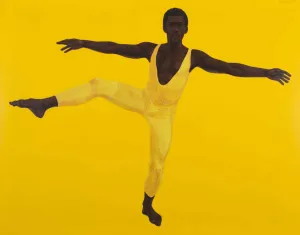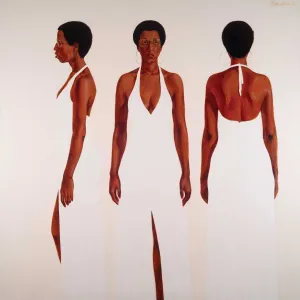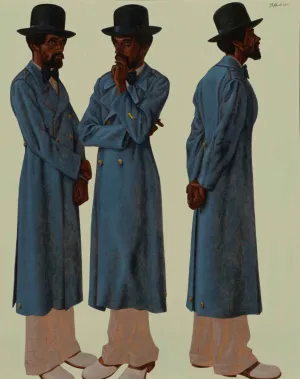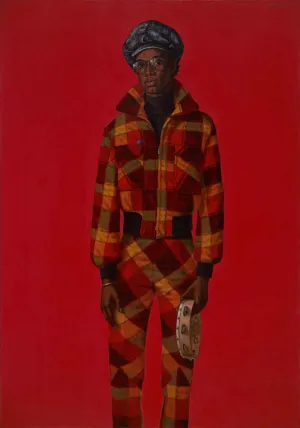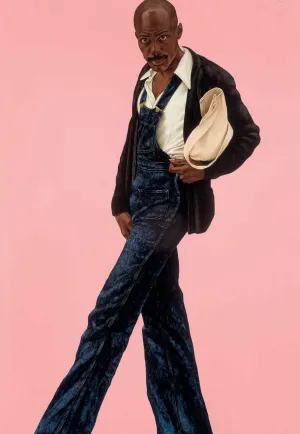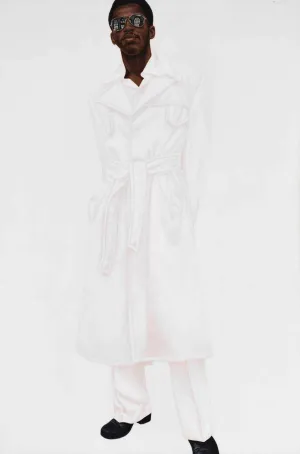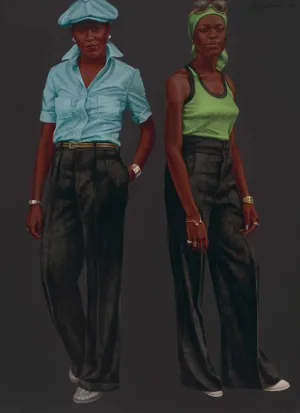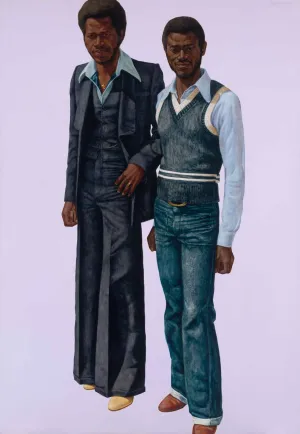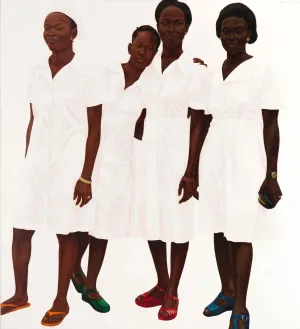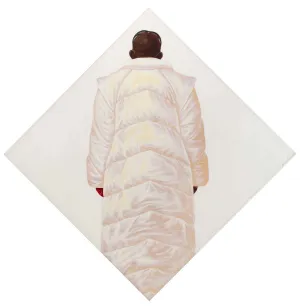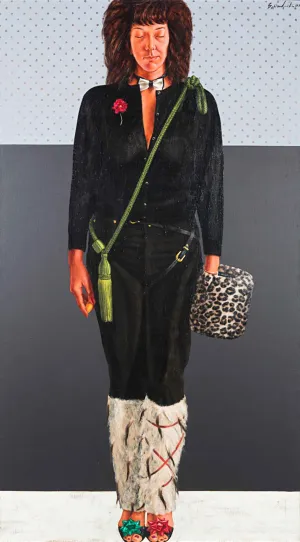Checklist
Barkley L. Hendricks (American, 1945–2017)
Lawdy Mama, 1969
Oil and gold leaf on canvas
53 3/4 x 36 1/4 in. (136.5 x 92.1 cm)
Studio Museum in Harlem; Gift of Stuart Liebman, in memory of Joseph B. Liebman
© Barkley L. Hendricks. Courtesy of the Estate of Barkley L. Hendricks and Jack Shainman Gallery, New York.
This portrait of the artist's relative Kathy Williams was inspired by Byzantine and early Italian Renaissance paintings. In them, gold-leaf backgrounds signal the divine, conveying through material splendor the importance of the devotional object, prompting wonder and meditation. Hendricks learned the painstaking process of applying gold leaf after returning from Europe in 1966.
Barkley L. Hendricks (American, 1945–2017)
Miss T, 1969
Oil and acrylic on canvas
66 1/8 x 48 1/8 in. (168 x 122.2 cm)
Philadelphia Museum of Art, Philadelphia; Purchased with the Philadelphia Foundation Fund, 1970
© Barkley L. Hendricks. Courtesy of the Estate of Barkley L. Hendricks and Jack Shainman Gallery, New York.
On his first trip to Europe in 1966, Hendricks was struck by a portrait in the Uffizi gallery, in Florence, by the Italian Renaissance artist Giovanni Battista Moroni: “The figure in a black, skin-tight outfit made me see the illusion of form and simplicity in a different light.” Miss T was a “direct by-product” of this encounter with the four-hundred-year-old painting. Hendricks’s subject, Robin Taylor, was his then-girlfriend: “Several paintings come with good color besides what’s on their canvases.
Transcript
Speaker: Richard J. Powell on Miss T
I’m Richard J. Powell, I’m the John Spencer Bassett Professor of Art and Art History at Duke University in Durham, North Carolina.
Barkley was ahead of his time. Barkley was very attuned to not just bodies but their accoutrements. And fashion is a part of the bigger picture for Barkley L. Hendricks and his work. Fashion is something that’s quite obvious and visible on the streets of America during this time period. When you see these paintings, you really understand a moment in some ways that other artists simply don’t address.
Miss T is 1969 personified. She is very much of that moment. I’m also a child of the 60s so I remember the clothes from that era that were tight around the hips and waist, but then the legs would just flare out. And also these accents like the chains on the hips. This is an element of fashion that is unnecessary, and that is the art of fashion in the late 60s early 1970s. It’s an era of excess, plastic, fake fur, just all sorts of things that speak to elaboration beyond elaboration but make a statement.
What I like about Miss T is the way it balances or volleys between figural representationalism and abstraction. I love how Barkley employs a kind of a hyperrealistic approach to painting, where we see her features so carefully delineated, where we see the details of her clothing so finely created and fashioned. But then, you take the painting as a whole and you are engaging with a shape that is set against a white field. And that shape against the white field has a kind of a charge, has a kind of an excitement. And I can’t help but feel that Barkley, despite being a realist painter, also understands the power of painting. And therefore chroma, and pattern, and design, and all of those elements that go into fundamental painting he’s using even within the context of something that’s figural and representational.
Something else I like about it, I’ll just say, is that this is a moment of heightened consciousness on the parts of African Americans. I believe the rallying cries of “Black is Beautiful” were being shouted and voiced all throughout the late 1960s. I can’t help but look at Miss T and think that what Barkley has done is he has visualized “Black is Beautiful” without having a label, without having a big sign that says “Black is Beautiful” or “Black power,” even. When I look at Robin Taylor’s body and in particular her head, I’m thinking about the afro hair fashion of that time, not just being a celebration of natural hair but once it is combed out, once it is pushed out into the world from someone’s head, it gives the feeling of something very proactive, of something very assertive, of almost a fist . It’s a body in the shape of a fist, and Barkley has captured that.
I first met Barkley here in New York City. He had a show, I believe it was on Madison Avenue actually, and I went to the gallery. You know, it wasn’t until later when I got to know him that I realized he was a dandy. And that he was really into shoes, and particular styles of clothing, and it was just fun to see him come up with interesting—as we say in the vernacular—“getups.” But they were never out of taste; they were cool. So, with Barkley’s fashions on his own body one can really see that he is a child of Philadelphia, a child of kind of urban style and elegance, that was him.
Barkley L. Hendricks (American, 1945–2017)
Woody, 1973
Oil and acrylic on canvas
66 × 84 in. (167.6 × 213.4 cm)
Baz Family Collection
© Barkley L. Hendricks. Courtesy of the Estate of Barkley L. Hendricks and Jack Shainman Gallery, New York.
This is one of the earliest of the paintings Hendricks described as having a “limited palette”—works in which the figure (except for the skin) and background are presented nearly monochromatically. The varnished oil paint used for the figure contrasts with the matte acrylic of the background to create a distinction in materials and surface visible only when the paintings are viewed firsthand. Striking one of the most dramatic poses of any of Hendricks’s figures, the subject was recently identified by Richard J.
Transcript
Speaker: Antwaun Sargent on Woody
He was always, in all of his paintings, always bucking dominant notions and dominant perspectives within the Black community and those who were outside the Black community. And, Woody is a perfect example of that.
He was a stylist on the canvas. In the photographs that Barkley took, and he took many of them, you see him sort of doing these different poses, some dynamic, some a portrait of Woody’s face, some of him caught in these solemn moments. He makes the entire leotard that Woody is wearing yellow, which is not the case in the photograph. He removes the background. The background in the photographs are this sort of wooded area and, in the final painting it’s yellow on yellow, and it sort of not only makes it a more dynamic and warm painting, but it also gets at some of the other art historical questions that Barkley was negotiating in his practice, in that period: this movement towards minimalism, abstraction, color field painting and Pop, then obviously this conversation between portraiture and the history of portraiture.
This image is able to do all those things, but then it also is able to think about this particular Black male figure beyond some of the ways in which Black men then and now and throughout history in a lot of ways has been stereotyped. You have this Black male figure rendered as a ballet dancer, and those contrasts between what was sort of happening in mass media, I’m sure Barkley was sort of paying attention to that, and what he knew a Black interiority to be. That’s also one of the powers of this painting: because it has a deep sense of interiority, and balance, and so he’s balancing on one leg and also spreading his limbs and so there’s a great freedom but balance. All of these really interesting layers from the art historical perspective but also in terms of the sort of socio-political perspective in terms of what representation of Black men did Barkley want to put out in the world.
I first met Barkley Hendricks, it had to be at Jack Shainman Gallery. He always had his camera. He was almost always with Susan, his wife, I never spoke to him because I was always sort of in awe and just didn’t. I was like, one day I’ll interview him. And that came when he had what would become his final exhibition at Jack Shainman Gallery. That was sort of a radically different body of work than we had known, and he was, after taking what became a 20-year hiatus, he was back interested in creating portraits, and we were all really excited because in some ways the moment had caught up to Barkley. It felt perfect in the sense that the art world had finally caught up to his experimentations in portraiture.
I just remember being on a call with him and I started to ask some questions and I was struck by how unsubtle those paintings were. They had really touched on some real racial chords in American society, and then what was happening there in sort of a post-Donald Trump election period and the rise of Fox news, and this question around the confederacy and the monuments. We’re having all these conversations as a nation, and Barkley’s just painting that into the work. So, you had a Black male with a Fox news sweatshirt on grabbing his crotch in a humorous Barkley Hendricks sort of way. But you couldn’t divorce some of the more political overtones, and I asked him about that, and he was not having it. And looking back he was still someone that did not want to be defined, and the more you pushed–and I did as a journalist at the time–he was like “what about the flatness of the background, and what about the way that I’m using abstraction and minimalism, what about…” you know, he was a lot more interested in the un-obvious aspects of those works and frankly became a little annoyed with me in my sort of trying to pin him down, which in hindsight, is about an artist not willing to be defined by anyone but himself. I mean, it was the last time I spoke to him, and it left a real impression because I had I so admired what he had done in the dark, like no one cared you know in a lot of ways, and, he just kept going. I was so moved by the fact that he didn’t let that stop him and that he was vindicated in the way that the art world had moved into the consideration of Black portraiture.
The connection for me really was growing up in Chicago, and I would see these very figures that he rendered in paint, and gave stature and gave power and gave back their humanity and desire and choices around style and choices around how they move through the world, and there was this special kind of freedom that came with people that were otherwise written off by more dominant mainstream institutions and societal structures. I remember growing up around people like that and knowing that they had achieved a sense of freedom and a sense of living life on their own terms, though imperfect it may be. That for me is the thing that really drew me and draws me into a Barkley Hendricks portrait.
Barkley L. Hendricks (American, 1945–2017)
October’s Gone . . . Goodnight, 1973
Oil and acrylic on canvas
66 × 72 in. (167.6 × 182.9 cm)
Harvard Art Museums/Fogg Museum, Cambridge; Richard Norton Memorial Fund
© Barkley L. Hendricks and President and Fellows of Harvard College. Courtesy of the Estate of Barkley L. Hendricks and Jack Shainman Gallery, New York.
The Three Graces, figures from Greek mythology, was a popular motif for artists throughout early modern European art—from Sandro Botticelli to Peter Paul Rubens to Antonio Canova. Hendricks acknowledged the “direct influence” of the theme on this portrait of an unnamed Connecticut College student. She had sent anonymous letters to Hendricks, and, after he learned her identity, she posed for him. “She was married at the time,” he recalled, and her husband came to the studio.
Transcript
Speaker: Linda McClellan on October’s Gone . . . Goodnight
I’d been married for almost a year. My husband was in the military in Georgia, and he was just a second lieutenant; we didn’t have a lot of money. So, I was looking for jobs on campus, and one of the jobs was that you could model for the art classes. And I modelled for a couple of classes, and one of them was, well, no, the only one was his, I believe. At that point, he asked me would I pose for him. That’s how I met Barkley.
He had definite ideas about how he wanted me to look and dress. He said “bring some things over.” Basically, long dresses. So, I brought the one that as you see in the painting and a few more things. But he preferred that dress. Even though I only wore my glasses for reading, he wanted me to wear those. And he wanted me to wear red fingernail polish which I really never wear. And the big hoop earrings, which I did wear.
I knew as the painting progressed, that it was going to be white-on-white. And uh, I didn’t know why because how are you going to see the dress? It’s white; it’s on white. But you know, it turned out ok.
He didn’t talk a lot. He was very focused on his art. He was always concentrating on his on his painting. He did have music playing. He’d give me a break every now and then. But he was very, very focused. And I got really bored if you want to know the truth. I would be thinking about what I’m going to eat for dinner, if I have enough money for pizza, no probably not, things like that. I need to call my husband, I miss him. I was pretty much bored and tired.
I just figured it would be boxed up, it was going to stay in his studio. I had no idea. Because at the time he was an art teacher and I thought it was just practicing his craft. You know I had no idea he was going to really be as big a figure in the art world as he is. If I had I would’ve asked for more money. I would’ve said “hey Barkley how about maybe another hundred dollars an hour?” . But anyway. I’m sure he couldn’t have afforded it at that time.
When I used to pose for Barkley in his art class, it was full of females because you know initially Connecticut College was a female college. And they were all admiring him. I would not be surprised if there were girls in the class who were so enamored of him that someone in the class may have been writing him, but it wasn’t me. So anyway, never in my lifetime, wrote anonymous letters to anyone, but there were a lot of admiring young women there that one of them may have been writing him anonymous letters. I could see it. Because they were all very much taken with Barkley. Probably especially after he did his nude painting.
I had cancer of the scalp. And so, now I can’t grow my hair long anymore I have short hair again. After 50 something years. So, I look more like my painting now. Cause I used to have braids. Isn’t that interesting? Such a coincidence, isn’t it?
When I see those figures, I see my three daughters standing there. He never knew that was going to happen. But it just makes you think doesn’t it?
Speaker: Jack Shainman on October’s Gone . . . Goodnight
My name is Jack Shainman; I own the Jack Shainman Gallery here in New York City.
We met because he was in several of our group shows, and we kind of kept a friendship. He really liked Claude Simard, my partner in the gallery who passed away. They had a very special relationship. And Barkley would often just kind of show up at our front desk and all of a sudden, “Bah! Barkley Hendricks is here!”
He really did care where the paintings went. In fact, many of the early works were kind of earmarked for museum only.
October’s Gone we placed with the Fogg Museum at Harvard. Helen Molesworth was the curator, and Helen spent, I think, almost her whole yearly budget on this painting, although it was not so expensive at the time, compared to now. Because Helen wanted to retell the story, the art history that happened in the 60s, the 70s, into the 80s, because we have such kind of a myopic view of this very white, male-dominated art world, like nothing else was happening. Meanwhile, Barkley was happening, and if you look on this, the white-on-white painting, and dealing with this idea of form, line, abstraction, figuration, all together, was an important thing, and Helen really purchased this painting because she wanted to tell the right story, the true story, what was happening. It was a milestone, especially because he went to Yale, and all of that; he wanted his paintings to hang in places where they would be seen, and matter.
He was always open to listening, I think, I believe; but he was totally steadfast in his beliefs, probably more than anybody that I’ve ever met in my life. He really believed deeply in his values and in everything that he did.
Some of the meetings with journalists didn’t go so well, sometimes it became very combative . You know, a few that I can think of, maybe I shouldn’t mention their names, but in the New York Times once, quote-unquote, “After a combative interview with Barkley Hendricks,” but it went on to be a good review.
We had just such a lovely relationship; he was such an extraordinary man.
Transcript
Speaker: Linda McClellan on October’s Gone . . . Goodnight
I’d been married for almost a year. My husband was in the military in Georgia, and he was just a second lieutenant; we didn’t have a lot of money. So, I was looking for jobs on campus, and one of the jobs was that you could model for the art classes. And I modelled for a couple of classes, and one of them was, well, no, the only one was his, I believe. At that point, he asked me would I pose for him. That’s how I met Barkley.
He had definite ideas about how he wanted me to look and dress. He said “bring some things over.” Basically, long dresses. So, I brought the one that as you see in the painting and a few more things. But he preferred that dress. Even though I only wore my glasses for reading, he wanted me to wear those. And he wanted me to wear red fingernail polish which I really never wear. And the big hoop earrings, which I did wear.
I knew as the painting progressed, that it was going to be white-on-white. And uh, I didn’t know why because how are you going to see the dress? It’s white; it’s on white. But you know, it turned out ok.
He didn’t talk a lot. He was very focused on his art. He was always concentrating on his on his painting. He did have music playing. He’d give me a break every now and then. But he was very, very focused. And I got really bored if you want to know the truth. I would be thinking about what I’m going to eat for dinner, if I have enough money for pizza, no probably not, things like that. I need to call my husband, I miss him. I was pretty much bored and tired.
I just figured it would be boxed up, it was going to stay in his studio. I had no idea. Because at the time he was an art teacher and I thought it was just practicing his craft. You know I had no idea he was going to really be as big a figure in the art world as he is. If I had I would’ve asked for more money. I would’ve said “hey Barkley how about maybe another hundred dollars an hour?” . But anyway. I’m sure he couldn’t have afforded it at that time.
When I used to pose for Barkley in his art class, it was full of females because you know initially Connecticut College was a female college. And they were all admiring him. I would not be surprised if there were girls in the class who were so enamored of him that someone in the class may have been writing him, but it wasn’t me. So anyway, never in my lifetime, wrote anonymous letters to anyone, but there were a lot of admiring young women there that one of them may have been writing him anonymous letters. I could see it. Because they were all very much taken with Barkley. Probably especially after he did his nude painting.
I had cancer of the scalp. And so, now I can’t grow my hair long anymore I have short hair again. After 50 something years. So, I look more like my painting now. Cause I used to have braids. Isn’t that interesting? Such a coincidence, isn’t it?
When I see those figures, I see my three daughters standing there. He never knew that was going to happen. But it just makes you think doesn’t it?
Speaker: Jack Shainman on October’s Gone . . . Goodnight
My name is Jack Shainman; I own the Jack Shainman Gallery here in New York City.
We met because he was in several of our group shows, and we kind of kept a friendship. He really liked Claude Simard, my partner in the gallery who passed away. They had a very special relationship. And Barkley would often just kind of show up at our front desk and all of a sudden, “Bah! Barkley Hendricks is here!”
He really did care where the paintings went. In fact, many of the early works were kind of earmarked for museum only.
October’s Gone we placed with the Fogg Museum at Harvard. Helen Molesworth was the curator, and Helen spent, I think, almost her whole yearly budget on this painting, although it was not so expensive at the time, compared to now. Because Helen wanted to retell the story, the art history that happened in the 60s, the 70s, into the 80s, because we have such kind of a myopic view of this very white, male-dominated art world, like nothing else was happening. Meanwhile, Barkley was happening, and if you look on this, the white-on-white painting, and dealing with this idea of form, line, abstraction, figuration, all together, was an important thing, and Helen really purchased this painting because she wanted to tell the right story, the true story, what was happening. It was a milestone, especially because he went to Yale, and all of that; he wanted his paintings to hang in places where they would be seen, and matter.
He was always open to listening, I think, I believe; but he was totally steadfast in his beliefs, probably more than anybody that I’ve ever met in my life. He really believed deeply in his values and in everything that he did.
Some of the meetings with journalists didn’t go so well, sometimes it became very combative . You know, a few that I can think of, maybe I shouldn’t mention their names, but in the New York Times once, quote-unquote, “After a combative interview with Barkley Hendricks,” but it went on to be a good review.
We had just such a lovely relationship; he was such an extraordinary man.
Barkley L. Hendricks (American, 1945–2017)
Bahsir (Robert Gowens), 1975
Oil and acrylic on canvas
83 1/2 × 66 in. (212.1 × 167.6 cm)
Nasher Museum of Art at Duke University, Durham; Museum purchase with additional funds provided by Jack Neely
© Barkley L. Hendricks. Courtesy of the Estate of Barkley L. Hendricks and Jack Shainman Gallery, New York. Photo Brian Quinby.
Hendricks described the sitter as “a good friend from Philadelphia” who visited him in New London, Connecticut. The arched windows of Hendricks’s State Street studio are reflected in the eyes of the central figure. Like October’s Gone . . . Goodnight, Bahsir draws on the classical motif of the Three Graces, the triple-portrait format suited for subjects for whom he “felt that one pose was not enough.” Here, however, two of the figures slightly overlap, enhancing the illusion of the bodies in space.
Transcript
Speaker: Trevor Schoonmaker on Bahsir (Robert Gowens)
I’m Trevor Schoonmaker, Director of the Nasher Museum of Art at Duke University.
In February of 2008 we opened Barkley L. Hendricks: Birth of the Cool at the Nasher. He’d never had the big survey or the retrospective. There was no gallery that had all of his information, files, images, bio. The only place that existed was in Barkley’s own home, in his files. There was no archive to go to, other than Barkley himself. So, it was Susan, who played a really key role, Barkley, and myself. Barkley didn’t do email. We’d get on the phone, we’d talk some things through, and Susan and I would track it down. That catalogue, Birth of the Cool, I think people don’t realize the amount of detective work and labor that went into just producing the hard, factual information, beyond curating the show.
Bahsir we acquired maybe 9 months or a year before the show opens; we acquired it in 2007, and I’d honed in on what I thought were some of the most dynamic works that were still available in his personal collection, which was quite a bit at that time. I consulted Rick Powell who teaches at Duke. I’d only been a year at Duke, so I wanted to make sure we got this right. Rick and I agreed that Bahsir was the one because there are so few paintings with multiple figures, and Barkley maybe did only about three or so that had the same subject in multiple poses. It’s large scale, it’s a beautiful painting. There are a couple other directions we could have gone in; we thought that was the most majestic of the few.
I was explaining this to Barkley, I said “You know when I talk to artists, I hear the excitement in their voice about seeing your work and they may have only seen one painting at the Studio Museum in Harlem. And it made a huge impact of seeing themselves represented in the museum.” So, I was explaining that to him, and I said “now that people have access to your work with this show you’re gonna really see how influential you have already been and, that influence will only grow tremendously.” And he said, “Yeah, Trevor, we’re going to put on a great show, I love working with you, but I’ll believe all that other when I see it.”
When people saw his work in Durham, the response was overwhelming. I think he got to feel some of the feedback from a younger generation, and see it evidenced literally in their work, being influenced by him and in tributes, created in his honor, and I think that made him feel really good.
Barkley was as cool as you would imagine. He radiated cool, he radiated calm, very confident, he had an extraordinarily warm smile, a very embracing, welcoming smile that just puts you at ease. I’ve also seen him without the smile , not so much directed at me, but, he could have also at times be an intimidating figure. I think what’s odd today is, I think there is a younger generation that just assumed Barkley was always a hero and not this overlooked giant in the art world.
Barkley L. Hendricks (American, 1945–2017)
Blood (Donald Formey), 1975
Oil and acrylic on canvas
72 × 50 1/2 in. (182.9 × 128.3 cm)
Collection of Jimmy Iovine and Liberty Ross
© Barkley L. Hendricks. Courtesy of the Estate of Barkley L. Hendricks and Jack Shainman Gallery, New York.
Donald Formey was a student at Connecticut College. For this limited-palette painting, Hendricks altered the sitter’s clothes as he did in many of his portraits. Formey had worn jeans to model, but Hendricks painted him wearing plaid pants that matched the pattern of his jacket. Over the course of the sittings, Hendricks added the tambourine. Formey recounts that the artist gave him the instrument to pose with after he noticed him tapping his foot to the music playing in his studio.
Transcript
Speaker: Donald Formey on Blood (Donald Formey)
The first time I actually saw him or heard of him was actually in his class. It was the first day of class. And it was really a different experience, even the first day. We’d see him around campus all the time, but I was lucky enough to choose to be in an art class the first year. And it was not like any art I’d ever seen before.
Well, you know, I’m from the south, you know that’s the bible belt, and the first day of class there was a nude person, a lady, over to the right. I’m like “what in the world…”, and then over to the left there was a nude guy. And I’m like “Uh Toto, we’re no longer in Kansas.” And it was really a different experience. And this teacher was like the coolest guy you’d ever seen, or ever met, he was always the same demeanor, he’d be smiling but usually kind of quiet. And he had his Fu Manchu mustache going, he had earrings, and I, you know, I wasn’t really used to any—I wasn’t used to the earrings anyway, coming from Georgia. He’d made everybody feel pretty comfortable, he’s a great guy.
I would call him Professor Hendricks in class, you know—but he wanted us to call him Barkley, so we ended up doing that. My mama, she wouldn’t want me calling no grown person by their first name like that . Oh, I was grown but I was a kid, I was like what, 18 at the time? And so that’s been a long time ago. But you know I’ll always remember him because he was always the nicest guy, no matter where you saw him. Race meant nothing to him, whatsoever, you know. And back then in the 70s you know that was the Civil Rights Movement and all that stuff, but he kind of was a person that was kind of a loner in a way to himself, but he got along with everybody. It didn’t matter who you were, he made everybody feel comfortable. And me especially, I was from the South, and, you know not too many people in that school were from the south, you know, let alone folks with my ethnic origin in that particular school, and he always made me feel kind of comfortable. He painted a whole lot more cooler people than me. And you could flip through that book and you can tell, I mean these guys have these cool outfits on. That was that was my jacket, and that was my cap, but it wasn’t my pants. And he just kind of, he got creative, you know, and I’m kind of famous for that suit now I guess, so….
Believe me it’s not a big time jacket I’m not even sure where I got it from. It was like your regular department store you know, and I was in Connecticut. It seemed like a lot of folks were dressing in these bright colors and stuff and I just was trying to fit in. And the cap, no that was, that was a Donald specialty there, I’d wear that anywhere you know, and I still do with these kind of caps, you can see, just little more mature type.
He came to me one day after class and he just asked me point blank, would you consider me painting a portrait of you. And I was honored to hear it, you know, because I mean, nobody ever asked me to do that before, and I wasn’t always a person that was in the forefront of anything, but I was glad to do it because I liked him as a person, and he was always real nice as a teacher and everything else. So, he just asked me would I do it and I told him yes, and he invited me to his home to do it and when I went into his home it was like this big art studio on the inside. Maybe unfinished paintings and stuff like all over the place. And I was standing there, and he was playing some kind of jazz or something like that, and I was just tapping my foot and he goes “Oh, very musical” and he found a tambourine that he had, and he asked me did I mind holding it? I told him no, cause you know back then tambourine was pretty cool. I mean in all the parties and stuff on campus I used to go to the guy to, the tambourine was the man you know, so.. So, I was more than happy to do that.
He kind of like, brought to the forefront what I thought was cool anyway. He just kind of validated that for me but . I couldn’t believe he asked to paint me though. I didn’t really realize exactly how famous he was, until I was actually out of school. I didn’t know. Yeah, I saw his picture on his, you’ve heard of Dewar’s liquor? He was on Dewar’s profiles once when I was back home, out of college, I go “Hey, hey!” telling everybody, “This is, this is my friend and my professor.” I was so impressed, and amazed, and turns out that more than an art professor, he was just a real, real deep guy.
It was amazing. I was mesmerized, like just stand and just stare at it for the longest time. And I was a person, like I was not really all that popular necessarily around campus until that happened. And I would like you know, I don’t know if you have ever been in the Cummings Art Center where it was, but down in that sort of area, courtyard, on the outside, you could look up and see my portrait through the window, for like, two or three months? You know, I’m like “unbelievable,” I was a big star . I pretty much have to give him credit for that. I was no longer invisible. And, everywhere I’d go, students would be like, I was all of a sudden this popular guy that I wasn’t before.
I’ll never forget him. I talked about him all the time, even before I realized how popular this painting would end up being. I would, you know talk about him with my family and friends back home all the time. I mean just the coolest guy imaginable. He really was. My man.
Barkley L. Hendricks (American, 1945–2017)
Misc. Tyrone (Tyrone Smith), 1976
Oil and Magna on canvas
72 × 50 in. (182.9 × 127 cm)
The George Economou Collection
© Barkley L. Hendricks. Courtesy of the Estate of Barkley L. Hendricks and Jack Shainman Gallery, New York.
The artist encountered Tyrone Smith in downtown Philadelphia and asked to take his photograph. As Hendricks recalled, Smith “went into a whole theatrical posing thing . . . it looked like a photo shoot.” The crowd that formed applauded when they finished. Working from the photographs in his studio, Hendricks set Smith’s angular pose against a vibrant pink background, inspired perhaps by his sense of his subject’s personality. Like many artists before him, Hendricks ventured onto the city streets for inspiration.
Barkley L. Hendricks (American, 1945–2017)
Steve, 1976
Magna, acrylic, and oil on linen
72 × 48 in. (182.9 × 121.9 cm)
Whitney Museum of American Art, New York; Purchase and gift with funds from the Arthur M. Bullowa Bequest by exchange, the Jack E. Chachkes Endowed Purchase Fund, and the Wilfred P. and Rose J. Cohen Purchase Fund
© Barkley L. Hendricks and the Whitney Museum of American Art / Licensed by Scala / Art Resource, NY. Courtesy of the Estate of Barkley L. Hendricks and Jack Shainman Gallery, New York.
Hendricks photographed the subject against a graffiti-marked wall, which he replaced in this painting with a matte-white background. How and when the artist met the subject is unknown. Reflected in the sunglasses are the windows of Hendricks‘s State Street studio. Such meticulous architectural details, along with the miniature self-portrait at the right side of the glasses, evoke the paintings of the fifteenth-century Flemish artist Jan van Eyck, whom Hendricks admired.
Barkley L. Hendricks (American, 1945–2017)
Slick, 1977
Magna, acrylic, and oil on canvas
67 × 48 1/2 in. (170.2 × 123.2 cm)
Chrysler Museum of Art, Norfolk; Gift of the American Academy and Institute of Arts and Letters, New York
© Barkley L. Hendricks. Courtesy of the Estate of Barkley L. Hendricks and Jack Shainman Gallery, New York.
Regarding self-portraiture, Hendricks wrote: “‘Since you are always around’ was one of the descriptions I heard to define self-portraiture.
Transcript
Speaker: Elisabeth Sann on Slick
My name is Elisabeth Sann, and I am a Senior Director at Jack Shainman Gallery in New York.
It was such a privilege working with such a legendary artist.
Probably our first interaction was them, Susan and Barkley, standing at the front desk and Barkley probably taking a picture of my heels. I wore very high heels back then when I cared to ; he probably took a picture of my shoes before saying hi.
He could not be bothered with the art market. It lived completely outside of what he was interested in. It was contrary to a lot of the things he was interested in. He knew he was a painter and to live as a painter you have to sell your paintings, and I think he knew it was a necessary evil, but he did not like that aspect of being an artist. We talked about it a lot .
I think a lot of the times his self-portraits were when he was most playful. What a lot of people overlook is the convenience of having yourself as a model. If you have an idea, you can just do it, because you’re there, you’re available, you don’t have to direct someone. Like in Slick, it’s a joke about himself, it’s a joke his sister made to him, and he was like, “Oh yeah maybe I am slick.” And that’s true with, I think, all of his self-portraits. They are very tongue in cheek, they’re little private inside jokes, they’re beautifully painted, so people can engage with them on that level, but also there are these little jokes and little Easter eggs hidden in them that people can have a deeper interaction with.
Barkley was never concerned about what people thought about him or about his art. I think he always thought that if people didn’t get it, then they didn’t get it, maybe they’ll get it later. But the art is what it is. I think he was into personal fashion as his own way of expression too, but I don’t think he cared what people thought of how he looked, how he dressed, it was just for himself. And his paintings were just for himself too.
Barkley L. Hendricks (American, 1945–2017)
Sisters (Susan and Toni), 1977
Oil and acrylic on canvas
66 × 48 in. (167.6 × 121.9 cm)
Virginia Museum of Fine Arts, Richmond; Funds contributed by Mary and Donald Shockey, Jr.
© Barkley L. Hendricks and the Virginia Museum of Fine Arts, Richmond. Courtesy of the Estate of Barkley L. Hendricks and Jack Shainman Gallery, New York. Photo Travis Fullerton.
Hendricks met the subjects in Boston. A comparison of the painting with photographs he took of the women—outside, against a wood-paneled wall—shows that he changed the colors of the hat and headscarf to match each woman’s shirt, limiting the range of colors in the composition, in which a deep gray predominates. He paid close attention to the rendering of their jewelry, especially reflections in the metal. A tiny reflection of the woman wearing green appears in the spherical earring of the woman in blue.
Barkley L. Hendricks (American, 1945–2017)
APB's (Afro-Parisian Brothers), 1978
Oil and acrylic on canvas
72 × 50 in. (182.9 × 127 cm)
Yale University Art Gallery, New Haven; Janet and Simeon Braguin Fund
© Barkley L. Hendricks. Courtesy of the Estate of Barkley L. Hendricks and Jack Shainman Gallery, New York.
Hendricks encountered the subjects in Paris, recalling, “There was a style at the time with the long, slit-back suits that you saw a lot of tall, graceful African brothers wearing, and these gentlemen were gracious enough to allow me to photograph them.” He paid close attention to the depiction of their clothing, from the various textures and materials to the creases that animate a pant leg. Describing his approach to painting the illusion of denim, he remarked: “No one paints jeans like me, with the consciousness of the fact that jeans are a material that is worn rather than painted.
Barkley L. Hendricks (American, 1945–2017)
Lagos Ladies (Gbemi, Bisi, Niki, Christy), 1978
Oil, acrylic, and Magna on canvas
72 × 60 in. (182.9 × 152.4 cm)
Private collection
© Barkley L. Hendricks. Courtesy of the Estate of Barkley L. Hendricks and Jack Shainman Gallery, New York.
In 1977, Hendricks traveled to Lagos, Nigeria, to attend FESTAC (Second World Black and African Festival of Arts and Culture). There he met these women, who worked as cooks at a hotel. Photographs show them outdoors, standing on sandy ground. Transporting them to the flatness of a white-on-white painting, Hendricks showcases the range of the women’s skin tones and variety of their shoes.
Transcript
Speaker Dr. Zoé Whitley on Lagos Ladies (Gbemi, Bisi, Niki, Christy)
Lagos Ladies was completed in the year following FESTAC '77. It was described by Ebony magazine as a “family reunion” for the whole of the African Diaspora. It was held in Lagos, Nigeria. Pre-eminent attendees included musicians such as Stevie Wonder, Sun Ra, Gilberto Gil from Brazil, Miriam Makeba from South Africa, and writers such as Nigeria’s Wole Soyinka and the singer from Trinidad the Mighty Sparrow. Notably, for Barkley Hendricks, the festival was not the artist’s first time travelling outside the United States.
In fact, he told me that while he enjoyed travelling in Africa, he never felt compelled to alter his personal aesthetic as an artist to make it "more African," to visualize some immediately legible notion of Africa (using, say, a high-saturation color palette preferred by some artists or by referencing specific, recognizable West African textile patterns).
He was consistently drawn to people and so identifying compelling subjects for his work was just as easy in Lagos as it would have been in Philly or New Haven. Barkley considered his camera to be a “mechanical sketchbook.” He translated a photograph of a group of friends into this, one of his most enduring limited palette paintings. Their white uniforms establish a continuous field while their postures, expressions, accessories, and hairstyles each a very distinctive presence.
Hendricks' striking combination of slow-drying oil paint and fast-drying acrylic paint defines each woman’s pristine uniform, her skin tone and her distinctive jewelry. He adds to this the defining detail of each wearer’s shoes in yellow, green, red and blue. He crops the feet as a means of effectively conveying them as larger-than-life personalities, albeit on a slightly smaller than life-size scale of canvas.
Make no mistake: had he wanted to depict the cityscape of Lagos, he would have been up to the task! He spent every summer painting precise landscapes in Jamaica and also spent considerable time in Ghana. He had a very particular intention when painting people. He was drawn to them, not their surroundings.
Barkley L. Hendricks (American, 1945–2017)
Omarr, 1981
Oil and acrylic on canvas
48 × 47 3/4 in. (121.9 × 121.3 cm)
Courtesy Barkley L. Hendricks Estate and Jack Shainman Gallery, New York
© Barkley L. Hendricks. Courtesy of the Estate of Barkley L. Hendricks and Jack Shainman Gallery, New York
In historical European art, the Rückenfigur (back figure) motif is meant to allow viewers to imagine themselves in the position of the painted figure, whereas in early 1980s America, the figure seen from the back connects to a history of protest and signals a refusal to comply. However, this painting, one of a handful of single-figure portraits by the artist depicting the sitter from behind, need not refer to either of these associations. Hendricks was adamant that his art was not political, that he simply painted what he saw.
Barkley L. Hendricks (American, 1945–2017)
Ma Petite Kumquat, 1983
Oil, acrylic, white gold, and silver leaf on canvas
72 x 40 in. (182.9 x 101.6 cm)
Collection Ben and Jen Silverman
© Barkley L. Hendricks. Courtesy of the Estate of Barkley L. Hendricks and Jack Shainman Gallery, New York.
Hendricks painted this portrait of his wife, Susan, shortly after the couple married. The title comes from the small orange fruit held in the sitter’s hand: “I needed an additional warm color. So that little piece of citrus...gave the painting just what it needed as well as its name.” Susan modeled both for photographs and for live sittings, and Hendricks later added accessories like the green curtain pull, bow tie, muff, leg warmers, and bows on the shoes. He applied the silver-leaf dots on the upper register using the back end of a pencil.
Transcript
Speaker: Susan Hendricks on Ma Petite Kumquat
He would have music on, he would have jazz on. Always. In the house, always jazz, from the minute he woke up in the morning til he went to bed. In multiple rooms, usually, probably multiple things playing. But no, no talking. It would have changed my mouth.
I don’t think he dressed me cause that is something I would wear, that outfit, sans the belt, but the black on the black, that vintage sweater was all beaded up in here. And that was a pair of tight corduroys. I think I added the disco belt and—fun fact—this disco belt thing that was around and then through the leg was also, I sort of copycatted that from another subject of his, Barbara from Something Like a Bird (Double Barbara). And she sort of preceded me in the disco time. We bartended at the same place where Barkley and I met.
I did the photoshoot, and then he took the painting to the point where he wanted to add the leggings, the muff, the—this is a curtain tie—the rose. The legwarmers, which I think it was rabbit, I’m not sure what kind of fur, but he put those on a mannequin leg and wrapped them with the ribbon, which then matches a couple of bows. Those were added later and I think those were on Christmas presents I gave him that year, so that would have been 1982, and this was a muff that he got from a vintage store in New London that he had hanging out in the studio.
But the only posing I did where he painted me from life was, I wasn’t even wearing the outfit, I stood where there were a lot of lights in the house, and he had me stand with my eyes closed—my glasses off and my eyes closed. And that was maybe, I don’t know, an hour, and then a break, and then another hour, and then another break. I did have the heels on. So, standing, in heels, with your eyes closed, is a very tippy proposition. So, it wasn’t the most comfortable thing. And as I said once before in a video, it wasn’t the most fun I ever had with Barkley Hendricks.
I didn’t really see what he was doing; he didn’t let me look after he was done painting, painting my face, and my hair, and the shadows on my face, and I think I came back later, and he had me hold my hand separately so that he could put the kumquat in.
The kumquat was actually based on another portrait that he did of Andy. Andy was a very close friend of ours; Barkley met him at Connecticut College, and Andy was from St Vincent in the Caribbean, and loved tropical fruits. And he introduced Barkley to kumquats. So, Barkley always told me that I was kind of like a kumquat, sweet on the outside, sour on the inside, or maybe the reverse. But anyway, he said it was the diversity of inside to outside that he always found interesting, and comparative to the kumquat for me.
This was finished I think right before our wedding. It was Picasso and Gertrude Stein. He did a portrait of her that had her eyes either crossed or her eyelids were sagging or something. And when she saw the portrait, she said, “But I don’t look like that.” And he said, “But you will.” So, with this painting, I said the same thing: “My hair isn’t fluffy like that.” It was a much shorter curl; I mean it was the length but shorter. I said, “My hair doesn’t look like that.” And he did the Picasso thing. He said, “It will!” And it did. And it does.



